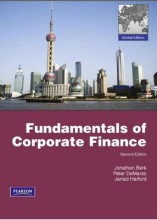Summary Corporate Finance
- This + 400k other summaries
- A unique study and practice tool
- Never study anything twice again
- Get the grades you hope for
- 100% sure, 100% understanding
Read the summary and the most important questions on Summary Corporate Finance
-
20 Financing with Debt
This is a preview. There are 18 more flashcards available for chapter 20
Show more cards here -
Which two types of bank loans exist? Name their characteristics
1. Line of credit = short-term arrangement between bank and firm. the bank authorizes the maximum loan amount but not the interest rate
2. Loan commitment = the bank lends a maximum pre-specified amount at a pre-specified interest rate -
What are the two types of loan commitment? Name their characteristics
1. Revolver = a fund flows back and forth between the bank and the firm without schedule
2. Non-revolver loan commitment = the firm cannot pay and borrow consecutively -
What are the 3 similarities between the general procedures of an equity issue and a public issue of bonds?
1. The offering must be approved by the board of directors
2. A registration statement is prepared
3. If accepted, the registration statement becomes effective and the securities are sold -
What are two synonyms for face value of a bond?
1. Principal value
2. Par value -
Give the formula of the dirty price of a bond
Dirty price/invoice price (the price you pay) = clean price (quoted price) + accrued interest -
What two opposing effects of sinking funds on bondholders are there?
1. it provides extra protection to bondholders. if a firm experiences financial difficulties they would have trouble making sinking fund payments, which act as an early warning system to bondholders
2. It provides firms with an attractive option: if the bond prices fall below the face value, the company will satisfy the sinking fund by buying bonds at lower market prices. If bond prices rise above the face value, the firm will buy bonds back at the lower face value -
What is a call provision? And explain what is special about a deferred call.
It lets the company repurchase/call the entire bond issue at a predetermined price over a specified period.
A deferred call means that the company is prohibited to call its bonds for e.g. the first 10 years. During this period, the bond is 'call-protected'. -
On what 2 factors do debt ratings depend?
1. the likelihood that the firm will default
2. the protection afforded by the loan contract in the event of default -
Why do bond and share prices not change around a rating change?
Because the ratings are based on publicly available information, they probably don't in themselves supply new information to the market. -
Other words for junk bonds?
high-yield bonds, speculative bonds, low-grade bonds
- Higher grades + faster learning
- Never study anything twice
- 100% sure, 100% understanding
































